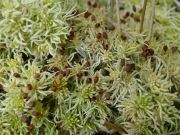A constantly changing flora
London is a complex mosaic of land surfaces and uses. No part of the LNHS area has a truly ‘natural’ flora, and there are few traces of the ancient flora in the urbanised centre. Nevertheless the ever-changing urban flora of adventive species (plants that have come from elsewhere, either as a result of commerce or as escapes from gardens) continues to provide much of interest in the inner city.
Our study area embraces a wide variety of habitats and the very activity which has caused the demise of many of the native species found two hundred years ago is responsible for the occurrence and establishment of numerous non-natives. Rodney Burton's 1983 "Flora of the London Area" (published by the LNHS) listed just over two thousand species, but recent additions and taxonomic changes make the current total considerably more than this.
A major factor influencing the range of wild plants found in London is the ‘heat island’ effect: the city is appreciably warmer than the surrounding countryside, having more frost-free days, more days above the minimum temperature for plant growth and higher Summer maxima.
In contrast, to the south of our study area the North Downs include many areas of easily accessible chalk grassland where there are many kinds of wild flowers, providing some fine examples of flower-rich semi-natural habitats.
Plants known as axiophytes (or indicator) plants are a valuable tool for understanding where the most important habitats in London are. Over the last two years, the LNHS Vascular Plant Recorder, Dr Mark A. Spencer, and Paul Losse from Salix Ecology have been working on an Axiophyte List for Greater London and Middlesex. Further information on axiophytes can be found on the BSBI website.
Bryophytes
Mosses and liverworts are a rewarding subject of study by naturalists: they are intrinsically beautiful in their own small way, and repay close study.
Bryophytes provide an excuse to get out into the field in the winter months when other botanical subjects are lacking − and indeed they are at their best then, easier to see without the shade cast by tree foliage, and most likely to be flourishing and producing capsules. They grow in many of the different habitats found in the London area − on bare earth, among grasses, on trees, stonework, wall tops, concrete, by rivers, canals etc.
It is an exciting time to be studying bryophytes in the London area, and because there are relatively few naturalists studying them there is still much for the amateur to contribute. Much of the difficulty of identification has been eased by the publication of the recent and very accessible British Bryological Society's Field Guide (follow menu choice "Resources" and then "BBS Field Guide Online").
LNHS Botanical Section organises occasional talks on bryological subjects and one or two field bryology meetings each year; meetings are also often organised by the Hampstead Heath Study group. Everyone is welcome to join these.
Fungi
Botanists of the future
As the effects of climate change become more apparent, the need for systematic recording of the changes in the distribution of our flora is urgent, and naturalists' societies such as ours have a vital role to play. Our field trips allow us to record London's changing flora while providing experience and learning opportunities for the budding botanists of the future. Some events are specifically for beginners, with no prior knowledge required, but whatever your level of knowledge you should find something of interest at all our meetings.








